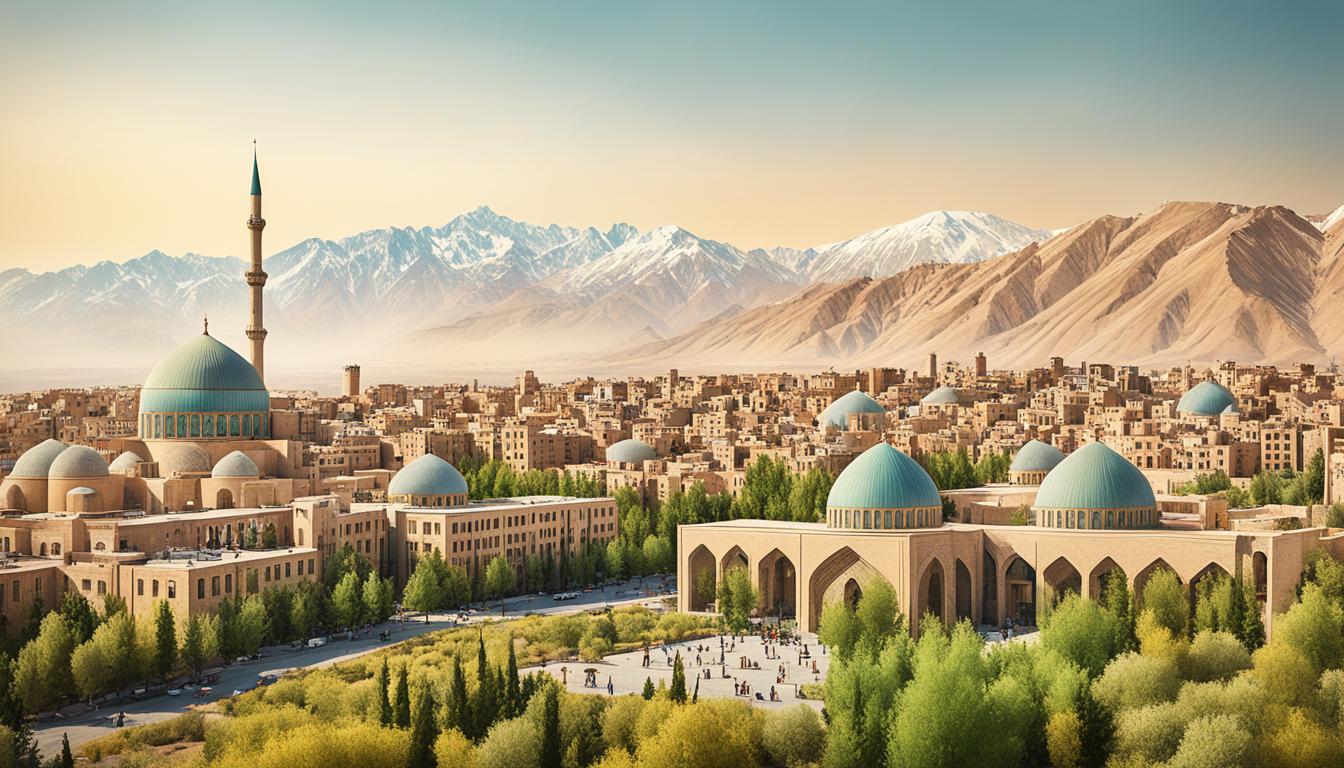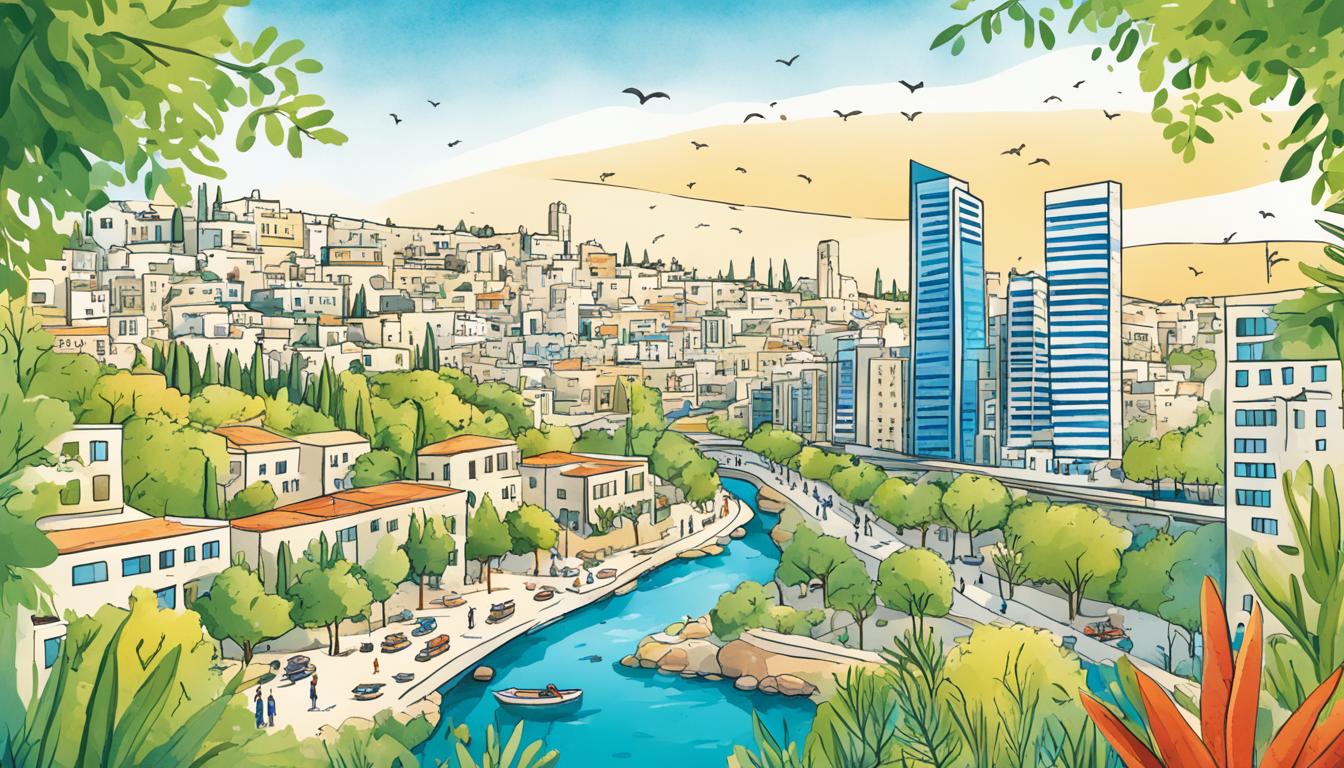Ireland Biodiversity and the Built Environment
Did you know that nature loss is happening at an alarming rate, with detrimental effects on our health and well-being? One of the main contributors to this loss is the construction and built environment sectors, which often have a negative impact on biodiversity and ecological diversity in Ireland.
However, all is not lost. Policies and legislation are now introducing stronger requirements for biodiversity in the built environment, leading to the emergence of sustainable architecture and urban planning practices that prioritize conservation efforts and green infrastructure.
In this article, we will explore the importance of biodiversity conservation in the built environment and how Ireland is taking steps towards environmental sustainability. We will delve into strategies for enhancing biodiversity in new builds and existing buildings, as well as addressing biodiversity loss in construction and demolition waste. We will also highlight the role of organizations like the Irish Green Building Council (IGBC) in promoting biodiversity and the built environment.
Get ready to discover how the interaction between Ireland’s urban development and ecological diversity can shape a more sustainable future.
Key Takeaways:
- Construction and the built environment contribute to nature loss and biodiversity decline in Ireland.
- Policies and legislation are driving the integration of biodiversity conservation in sustainable architecture and urban planning.
- Strategies exist to enhance biodiversity in new builds, major renovations, and existing buildings.
- Addressing biodiversity loss in construction and demolition waste is crucial for sustainable construction practices.
- The Irish Green Building Council (IGBC) plays a significant role in promoting biodiversity and the built environment.
Understanding the Links Between Construction and Biodiversity Loss
Biodiversity loss is a critical environmental problem that affects ecosystems and species worldwide. The construction and built environment sectors play a significant role in this loss, contributing to the decline of our planet’s natural resources. To address this pressing issue, it is essential to understand the links between construction activities and biodiversity loss.
The Intergovernmental Science-Policy Platform on Biodiversity and Ecosystem Services (IPBES) highlights five main drivers of biodiversity loss:
- Land-use changes
- Climate change
- Pollution
- Invasive species
- Overexploitation of resources
Construction activities, particularly the conversion of natural habitats into built environments, directly contribute to land-use changes and habitat destruction. As urban development expands, it encroaches upon ecosystems and displaces native plants and animals. Additionally, construction processes emit greenhouse gases, contributing to climate change, which further exacerbates biodiversity loss.
To illustrate the impact of construction on biodiversity, let’s examine some case studies:
Case Study 1: Urban Development and Species Displacement
A major construction project in a previously forested area led to the displacement of several bird species. The destruction of their natural habitat forced the birds to relocate or exposed them to increased predation risks. This case demonstrates the direct impact of construction on local biodiversity and the need for mitigation strategies.
Case Study 2: Pollution from Construction Activities
A construction site near a freshwater ecosystem released sediment runoff and chemicals into nearby water bodies. This pollution negatively affected aquatic biodiversity, leading to the decline of fish populations and disruptions in the food chain. The case highlights how construction-related pollution can have far-reaching consequences for ecosystems.
These case studies underscore the urgent need for biodiversity enhancement in construction projects. By adopting sustainable practices, such as preserving existing habitats, implementing green infrastructure, and using eco-friendly construction materials, we can minimize the impact of construction on biodiversity loss.
| Construction Practices | Impact on Biodiversity |
|---|---|
| Clearing natural habitats | Direct habitat destruction and displacement of species |
| Pollution from construction activities | Negative effects on aquatic and terrestrial ecosystems |
| Introduction of invasive species | Disruption of native plant and animal communities |
| Conversion of green spaces into built environments | Loss of critical habitats and ecological corridors |
By understanding the links between construction and biodiversity loss, we can drive change in the built environment sector and develop sustainable solutions that prioritize biodiversity conservation. Through collaboration, innovation, and informed decision-making, we can create a future where construction activities coexist harmoniously with nature.
Enhancing Resilience and Well-being Through Nature-based Solutions
Access to nature is vital for improving health, well-being, and the overall resilience of our urban environments. Nature-based solutions offer innovative approaches that not only enhance our surroundings but also contribute to climate resilience. By integrating nature into the built environment, we create spaces that promote both physical and mental well-being.
Nature-based solutions encompass a wide range of strategies and initiatives that harness the power of nature to address urban challenges. Green roofs, for example, are not only aesthetically pleasing but also provide numerous benefits such as improved air quality, reduced energy consumption, and enhanced biodiversity. These green oases in the midst of concrete jungles help mitigate the urban heat island effect, creating cooler and more comfortable spaces for people.
“Nature-based solutions offer innovative approaches that not only enhance our surroundings but also contribute to climate resilience.”
Sustainable urban drainage systems (SUDS) are another nature-based solution that can significantly improve the resilience of cities. These systems manage stormwater runoff by replicating natural hydrological processes, reducing the risk of flooding and protecting water quality. By incorporating SUDS into urban planning, we can create more climate-resilient cities and safeguard the well-being of communities.
Studies have shown that exposure to nature has a positive impact on our mental and physical health. Green spaces, such as parks and urban forests, provide opportunities for relaxation, recreation, and social interaction. They offer a respite from the stresses of city life and help combat mental health issues, such as anxiety and depression.
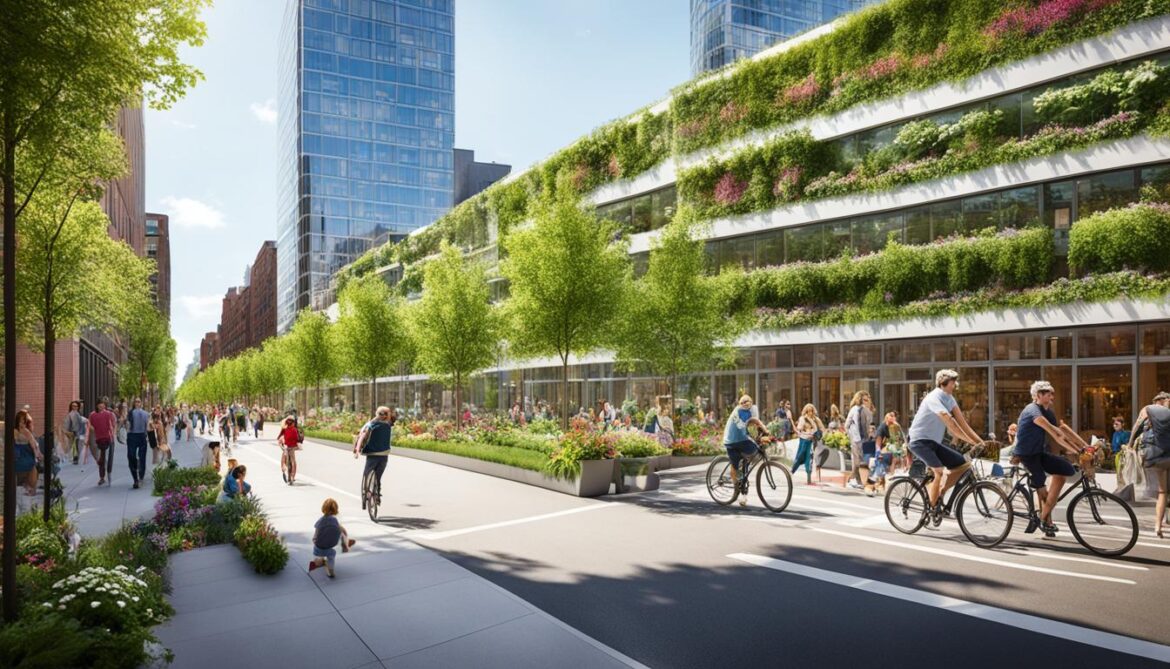
Furthermore, nature-based solutions contribute to climate resilience by mitigating the effects of climate change. Trees, for instance, act as natural air purifiers, absorbing carbon dioxide and releasing oxygen. They also provide shade, reducing the need for air conditioning and thereby lowering energy consumption. The integration of nature into urban environments creates healthier and more sustainable cities for future generations.
In conclusion, nature-based solutions play a crucial role in enhancing resilience and well-being in the urban environment. By incorporating green infrastructure, such as green roofs and sustainable urban drainage systems, we can create more climate-resilient cities while improving the health and well-being of communities. It is essential that we embrace these innovative approaches to shape a sustainable future.
Strategies for Biodiversity Conservation in New Builds and Major Renovations
As the population continues to grow, it is imperative that we prioritize strategies for biodiversity conservation in new builds and major renovations. By integrating sustainable approaches into construction projects, we can mitigate the negative impact on biodiversity and promote environmental stewardship for future generations.
Case Studies and Insights
Various case studies and experiences from experts in the field offer valuable insights into sustainable strategies that can be implemented in new builds and major renovations. These examples demonstrate the positive impact that thoughtful design and construction practices can have on preserving and enhancing biodiversity.
“We have seen remarkable success in incorporating sustainable features into our recent building projects. By implementing green roofs and using locally sourced materials, we have not only conserved biodiversity but also reduced our carbon footprint.”\n\n- Karen Thompson, Sustainable Architect
Key Sustainable Approaches
When planning new builds or major renovations, there are several key sustainable approaches that can be adopted to support biodiversity conservation:
- Preserving existing habitats and incorporating green spaces
- Using environmentally friendly materials and construction techniques
- Implementing energy-efficient design principles
- Managing stormwater runoff to protect waterways and aquatic life
- Creating wildlife-friendly features, such as bird boxes and insect hotels
Sustainable Strategies Benefits
By implementing these sustainable strategies, developers and homeowners can enjoy a range of benefits:
- Improved ecological balance within urban environments
- Enhanced aesthetic appeal and biodiversity value of properties
- Reduced energy consumption and greenhouse gas emissions
- Improved resilience to climate change
- Positive community impact through education and awareness
Biodiversity Conservation in Action
To better understand the impact of sustainable strategies in new builds and major renovations, let’s take a look at a practical example:
| Project | Description | Result |
|---|---|---|
| Green Office Complex | A new office complex incorporated green roofs, native plantings, and wildlife-friendly features. | The project achieved a LEED Platinum certification and provided a habitat for local bird species, contributing to the enhancement of local biodiversity. |
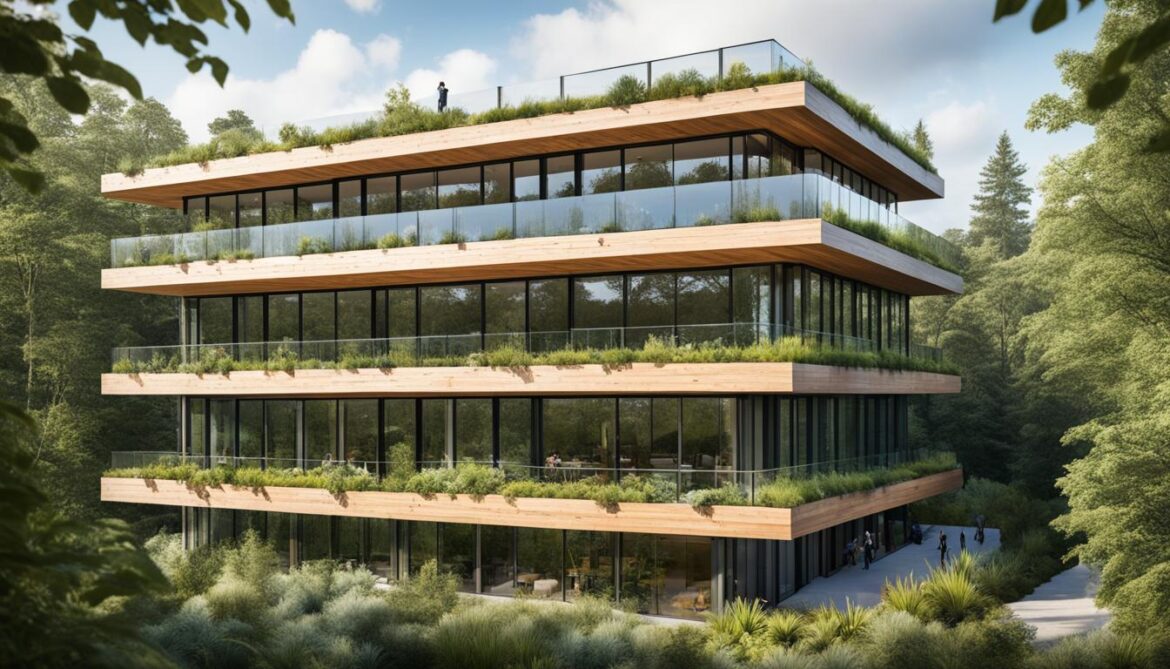
By implementing sustainable strategies in new builds and major renovations, we can strike a balance between development and biodiversity conservation. These measures not only protect and enhance our natural ecosystems but also contribute to the overall sustainability of our built environment.
Enhancing Biodiversity in Existing Buildings
Biodiversity enhancement is not limited to new construction projects. Existing commercial and residential buildings can also play a crucial role in connecting the built and natural heritage. By implementing landscaping, maintenance practices, and wildlife conservation efforts, these buildings can contribute to the enhancement of biodiversity and the preservation of our natural heritage.
Landscaping is an effective way to create habitats and support biodiversity. By incorporating native plants and trees, green spaces in existing buildings can attract a variety of wildlife, including birds, butterflies, and bees. These natural elements not only enhance the aesthetic appeal of the buildings but also provide food and shelter for local flora and fauna.
Maintenance practices also have a significant impact on biodiversity in existing buildings. Implementing sustainable landscaping techniques, such as using organic fertilizers and reducing pesticide usage, allows for the preservation of essential ecological processes while minimizing negative impacts on wildlife and natural habitats.
Furthermore, wildlife conservation efforts can be integrated into the design and management of existing buildings. Providing nesting boxes or bird feeders can support local bird populations, while bat boxes can provide suitable roosting spaces for these nocturnal creatures. These additions contribute to the creation of wildlife corridors and promote the coexistence of humans and biodiversity within urban environments.
“Enhancing biodiversity in existing buildings not only benefits the environment but also creates a healthier and more vibrant urban landscape.”
By taking these steps, existing buildings can become vital contributors to biodiversity enhancement in both urban and rural areas. These initiatives align with the preservation and promotion of natural heritage, ensuring a sustainable and ecologically diverse future.
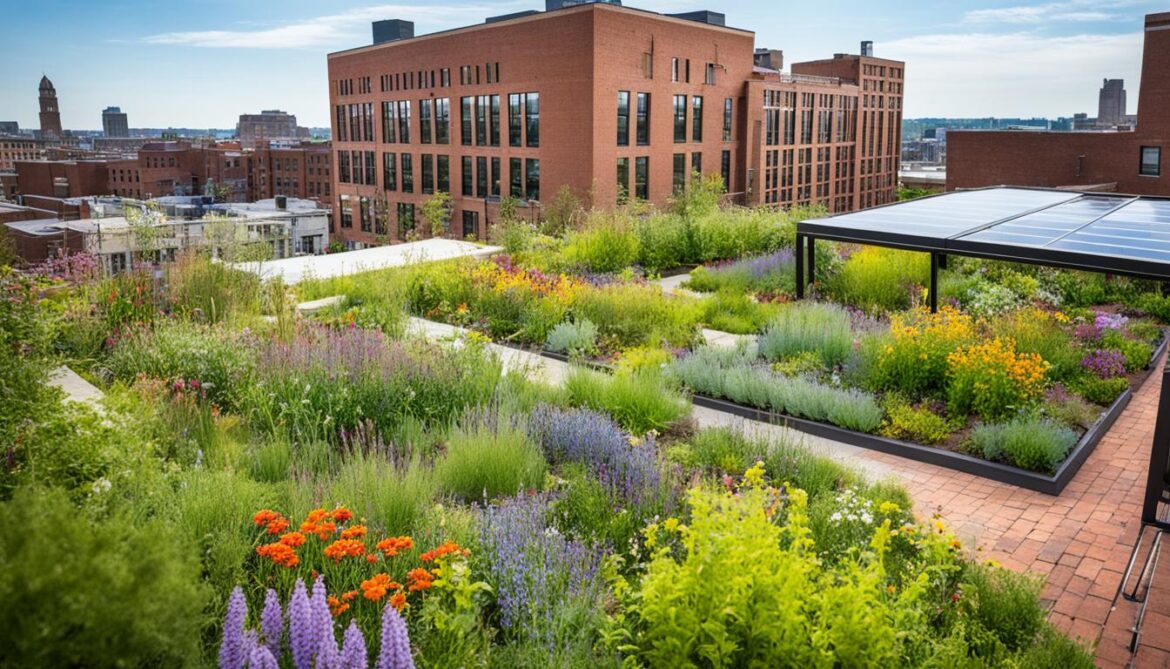
Case Study: Incorporating Biodiversity in a Commercial Building
To demonstrate the practical application of biodiversity enhancement in existing buildings, let’s examine a case study of a commercial building located in Dublin. The building owners recognized the importance of conserving biodiversity and took several measures to transform their property into a haven for wildlife.
| Actions Taken | Results |
|---|---|
| Conversion of rooftop space into a green roof with native plantings | Increased habitat for insects and birds, improved stormwater management |
| Installation of bat boxes and nesting habitats for birds | Support for local bat and bird populations, successful breeding and roosting |
| Reduction of pesticide usage and implementation of organic land management practices | Preservation of essential ecological processes, improved soil health |
| Creation of a small pond and installation of native aquatic plants | Increased habitat for amphibians, dragonflies, and aquatic insects |
This case study demonstrates that even small interventions in existing buildings can have a significant positive impact on biodiversity. By replicating these practices and sharing knowledge, we can inspire others to follow suit and create a network of biodiversity-rich urban environments.
Addressing Biodiversity Loss in Construction and Demolition Waste
The impact of construction materials and demolition waste on biodiversity goes beyond the construction site. The extraction and use of construction materials, as well as the disposal of demolition waste, can lead to embodied biodiversity loss. However, there are practical examples that demonstrate how we can address this issue and promote sustainable construction practices.
One such example is the use of recycled and reclaimed materials in construction projects. By choosing to incorporate these materials into new builds and renovations, we can reduce the demand for extracting new resources, thereby mitigating the negative impact on biodiversity. Additionally, using recycled materials can also contribute to a circular economy, minimizing waste generation.
Another practical example is the implementation of biodiversity-friendly practices during the demolition process. This includes salvaging and relocating plants and wildlife, as well as creating temporary habitats for species to thrive during the demolition phase. By prioritizing the protection and relocation of biodiversity during demolition, we can minimize the disturbance to ecosystems and reduce biodiversity loss.
Case Study: Sustainable Demolition and Construction
“Our company, EcoBuild, specializes in sustainable demolition and construction practices. We prioritize the conservation of biodiversity throughout our projects, implementing strategies such as salvaging materials and creating wildlife-friendly habitats. By working closely with ecologists and environmental experts, we ensure that our actions have a positive impact on both the built and natural environment.”
By adopting these practical examples and incorporating them into construction and demolition processes, we can minimize embodied biodiversity loss. This not only benefits the local ecosystems but also contributes to the overall environmental sustainability of the built environment.
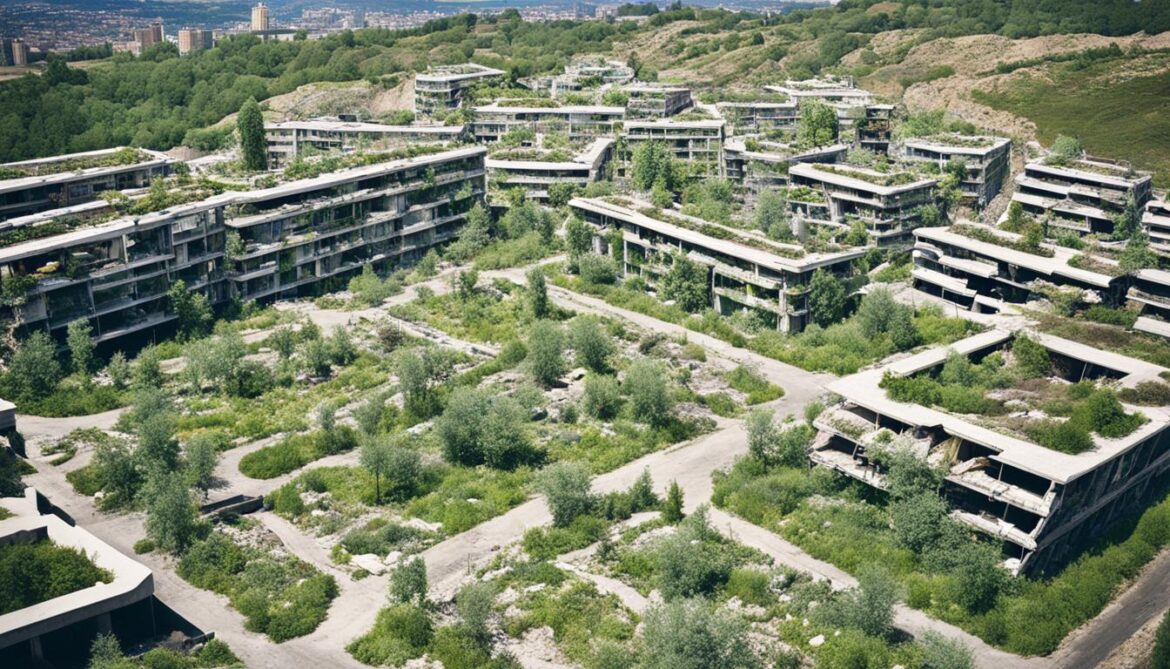
Benefits of Addressing Biodiversity Loss in Construction and Demolition Waste
| Biodiversity Conservation | Environmental Sustainability | Community Engagement |
|---|---|---|
| Preserves habitats for endangered species | Reduces resource extraction and waste generation | Enhances community well-being and pride |
| Creates wildlife-friendly habitats | Promotes circular economy principles | Provides educational opportunities |
| Supports ecological connectivity | Reduces carbon emissions | Promotes social cohesion |
Role of the Irish Green Building Council (IGBC) in Biodiversity and the Built Environment
The Irish Green Building Council (IGBC) plays a pivotal role in promoting biodiversity and sustainable practices within the built environment. As a leading authority in green building, the IGBC has launched a Community of Practice (CoP) dedicated to biodiversity and the built environment. This initiative brings together professionals, experts, and stakeholders to collaborate, share knowledge, and implement best practices to protect and enhance biodiversity in the construction and property industry.
The Community of Practice (CoP) serves as a platform for diverse voices and expertise to come together in addressing the challenges and opportunities of biodiversity in the built environment. By fostering knowledge exchange, the IGBC aims to empower professionals with the information and tools needed to integrate biodiversity considerations into their projects.
The IGBC’s CoP on biodiversity engages with architects, planners, developers, contractors, and other industry stakeholders to advocate for the integration of biodiversity into all stages of the built environment lifecycle. Through workshops, seminars, and networking events, the CoP facilitates discussions and collaborations that contribute to innovative solutions and practices.
The IGBC’s commitment to biodiversity extends beyond raising awareness and sharing knowledge. By actively promoting the implementation of sustainable strategies and green infrastructure, the IGBC supports the construction and property industry in making a positive impact on biodiversity conservation.
Benefits of the IGBC’s Community of Practice (CoP) on Biodiversity and the Built Environment:
- Facilitates collaboration between professionals, experts, and stakeholders
- Shares knowledge and best practices in biodiversity conservation
- Empowers professionals to integrate biodiversity considerations into their projects
- Advocates for sustainable strategies and green infrastructure
The IGBC’s Community of Practice (CoP) on biodiversity and the built environment stands as a testament to the organization’s commitment to fostering a sustainable future. By bringing together industry stakeholders and promoting collaboration, the IGBC plays a vital role in driving positive change and ensuring a harmonious relationship between the built environment and biodiversity.
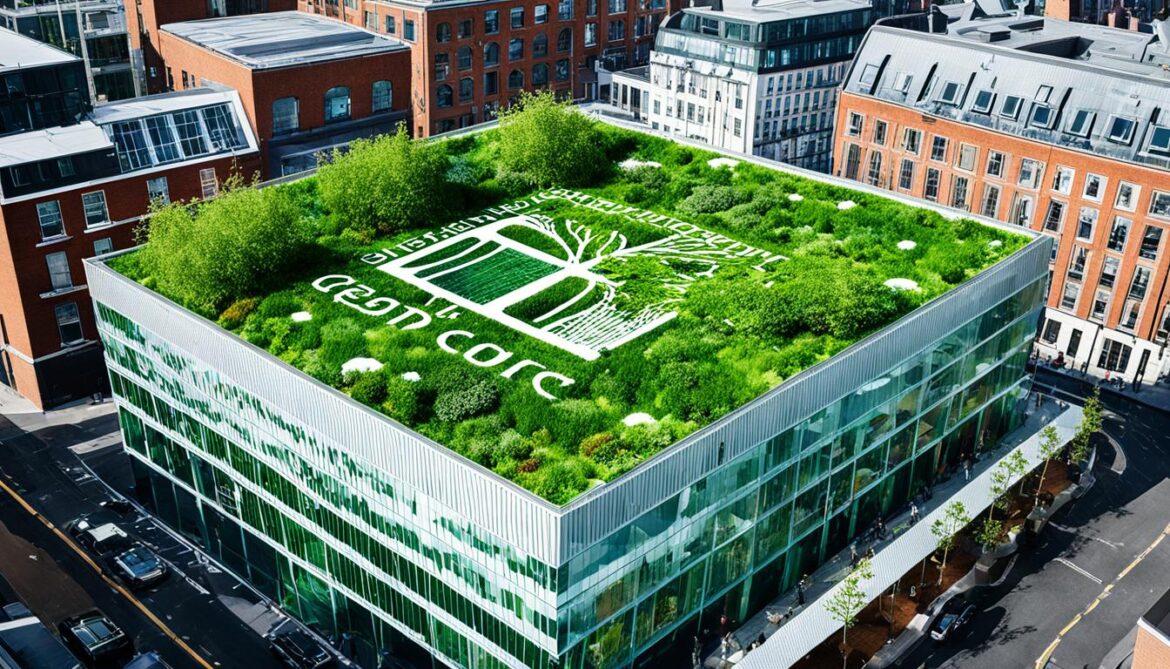
Importance of Regulating the Built Environment for Sustainable Living
Regulation plays a vital role in ensuring the sustainability of the built environment. With the escalating challenges posed by climate change and environmental degradation, it is imperative to have effective measures in place to protect our planet and plan for a sustainable future.
At the local, national, and EU levels, regulations provide the framework for managing the impact of human activity on the environment. They set the standards for sustainable construction practices, urban planning, and environmental management, ensuring that development is carried out responsibly.
Well-planned cities are integral to promoting sustainable living. Regulations guide the design and construction of buildings, making them more energy-efficient, environmentally friendly, and resilient to climate change. By incorporating green infrastructure, such as sustainable drainage systems and green roofs, cities can mitigate the negative impacts of urbanization on the environment and create healthier, more livable spaces for residents.
Moreover, regulations encourage biodiversity conservation in the built environment. They require the integration of nature-based solutions, such as wildlife-friendly landscaping and the preservation of natural habitats, into development projects. These measures enhance ecological diversity, support wildlife populations, and contribute to the overall health of ecosystems.
“Regulation provides the necessary framework for promoting sustainable living and protecting the environment. It ensures that development is carried out responsibly, with a focus on energy efficiency, environmental preservation, and biodiversity conservation.”
By regulating the built environment, we can also address issues related to waste management and resource consumption. Regulations drive the adoption of sustainable construction materials, waste reduction strategies, and recycling practices, minimizing the environmental footprint of the construction industry. This holistic approach to environmental management fosters a circular economy and promotes the efficient use of resources.
Ultimately, the regulation of the built environment is essential for creating a more sustainable and resilient society. It provides the framework for sustainable living, integrating principles of environmental stewardship, energy efficiency, and biodiversity conservation into the fabric of our cities and communities.
Benefits of Regulating the Built Environment
| Benefits | Description |
|---|---|
| Environmental Protection | Regulations ensure that development activities minimize harm to the environment and preserve natural resources. |
| Sustainable Construction | Regulations promote the use of energy-efficient materials and technologies in building design and construction. |
| Climate Resilience | Regulations support the implementation of climate-resilient strategies, such as green infrastructure and adaptation measures. |
| Biodiversity Conservation | Regulations mandate the integration of nature-based solutions, protecting and enhancing biodiversity in urban areas. |
| Waste Management | Regulations drive the adoption of sustainable waste management practices, reducing the environmental impact of construction and demolition activities. |
| Resource Efficiency | Regulations encourage the efficient use of resources, promoting recycling, and minimizing resource consumption. |
The Role of Environmental Management in Regulating the Built Environment
Environmental management systems play a crucial role in implementing and monitoring regulations related to the built environment. These systems help organizations assess and manage the environmental impacts of their activities, ensuring compliance with regulatory requirements.
By implementing environmental management practices, construction companies, architects, and developers can identify opportunities for improvement, reduce their environmental footprint, and enhance the overall sustainability of their projects. From conducting environmental impact assessments to implementing pollution prevention measures, environmental management systems support the effective implementation of regulations and contribute to the long-term sustainability of the built environment.

Conclusion
The Ireland Biodiversity and the Built Environment initiative highlights the significant role that sustainable architecture, urban planning, and conservation efforts play in preserving ecological diversity. By prioritizing biodiversity conservation and adopting green infrastructure, we can create a harmonious relationship between urban development and the natural environment in Ireland.
Through the implementation of nature-based solutions, such as green roofs and sustainable urban drainage systems, we can enhance the resilience of our cities while improving the well-being of their inhabitants. Access to nature and green spaces not only contributes to climate resilience but also positively impacts people’s health and quality of life.
It is crucial to implement strategies for biodiversity conservation in new builds and major renovations, ensuring that construction projects are designed and executed with the preservation of natural habitats in mind. Existing buildings, both commercial and residential, can also contribute to biodiversity enhancement through landscaping and wildlife conservation efforts.
By regulating the built environment and promoting sustainable living practices, Ireland can pave the way towards an environmentally sustainable future. The Irish Green Building Council’s Community of Practice on biodiversity and the built environment is a valuable platform for sharing knowledge, best practices, and collaboration, further strengthening conservation efforts in the construction and property industry.



